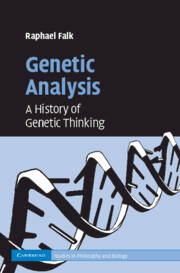Book contents
- Frontmatter
- Contents
- List of figures
- Acknowledgments
- Introduction
- PART I FROM REPRODUCTION AND GENERATION TO HEREDITY
- PART II FAKTOREN IN SEARCH OF MEANING
- PART III THE CHROMOSOME THEORY OF INHERITANCE
- PART IV GENES AS THE ATOMS OF HEREDITY
- PART V INCREASING RESOLVING POWER
- PART VI DEDUCING GENES FROM TRAITS, INDUCING TRAITS FROM GENES
- PART VII WHAT IS TRUE FOR E. COLI IS NOT TRUE FOR THE ELEPHANT
- Concluding comments
- Bibliography
- Index
PART V - INCREASING RESOLVING POWER
Published online by Cambridge University Press: 07 August 2009
- Frontmatter
- Contents
- List of figures
- Acknowledgments
- Introduction
- PART I FROM REPRODUCTION AND GENERATION TO HEREDITY
- PART II FAKTOREN IN SEARCH OF MEANING
- PART III THE CHROMOSOME THEORY OF INHERITANCE
- PART IV GENES AS THE ATOMS OF HEREDITY
- PART V INCREASING RESOLVING POWER
- PART VI DEDUCING GENES FROM TRAITS, INDUCING TRAITS FROM GENES
- PART VII WHAT IS TRUE FOR E. COLI IS NOT TRUE FOR THE ELEPHANT
- Concluding comments
- Bibliography
- Index
Summary
Continuity between the early reductionist ethos and the late anti-vitalist sentiment of Francis Crick, Jacques Monod and Linus Pauling … is suggested in the areas of fine structural genetic analysis, as in Benzer's wish to “translate linkage distances, as derived from genetic recombination experiments into molecular units”; the development of the operon theory … and the genetic code, as in Crick's legislative codification of molecular biological reductionism in the Sequence Hypothesis and the Central Dogma.
Fuerst (1982, 268)Toward the 1940s genetics became a self-confident autonomous discipline. The Nobel Prize awarded to Morgan in 1933 was a symbol of this autonomy and it certainly also added to its self-confidence.
During the first decades of the twentieth century, the methodology of hybridization analysis of discrete traits was established, and a conceptual framework for the mechanics of inheritance was formulated: genes were inherited entities that (within given environmental circumstances) determined the properties of morphological, physiological, as well as behavioral traits of living organisms; the chromosomal theory of inheritance situated the genes along the chromosomes and mapped them; the analysis of mutations combined with cytogenetic observations indicated that there was a material basis for the Mendelian Faktoren and demonstrated the mechanics of their inheritance. Geneticists in Morgan's group and elsewhere now invaded other disciplines and explored them more aggressively: Dobzhansky's Genetics and the Origin of Species (Dobzhansky, 1937) declared his intent to expand into the sphere of evolutionary research.
- Type
- Chapter
- Information
- Genetic AnalysisA History of Genetic Thinking, pp. 171 - 177Publisher: Cambridge University PressPrint publication year: 2009



